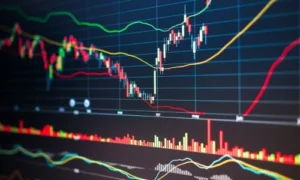ASX 200 Predictions for 2025: Can the Market Hit New Highs?

As Australian investors look ahead to 2025, one of the most common questions on their minds is whether the ASX 200 can continue its strong performance and potentially hit new highs. The Australian stock market has been through a period of volatility, with various global and domestic factors influencing its movement. However, the outlook for 2025 presents both challenges and opportunities. In this blog, we’ll delve into the key drivers that could shape ASX 200 performance in 2025 and what investors should consider as they prepare for the future.
Understanding the ASX 200 and Its Importance
The ASX 200 is a stock market index that tracks the performance of the 200 largest companies listed on the Australian Securities Exchange. It serves as a barometer for the overall health of the Australian stock market and is closely watched by investors, analysts, and economists. The index includes companies from various sectors, such as financials, mining, healthcare, and technology, which means its performance is influenced by the broader economic environment both in Australia and internationally.
For many investors, the ASX 200 represents a solid way to track the performance of the Australian economy and gain exposure to some of the country’s most influential companies. However, its performance in 2025 will largely depend on several key factors, both domestic and global.
Key Drivers of ASX 200 Performance in 2025
1. Global Economic Conditions
The global economic environment will play a crucial role in shaping ASX 200 predictions for 2025. While Australia’s economy is largely insulated from global market fluctuations due to its strong trade relationships, particularly with China, the global economy still impacts investor sentiment and market performance.
If global economic growth remains robust, especially in key markets like the US, China, and Europe, it could support strong earnings growth for ASX-listed companies. Conversely, if there are significant economic slowdowns, particularly in major trading partners, this could weigh on the ASX 200, leading to more cautious market sentiment.
2. Interest Rates and Inflation
Interest rates and inflation are two of the most important economic indicators for any stock market, and the ASX 200 is no exception. The Reserve Bank of Australia (RBA) plays a pivotal role in determining the cost of borrowing in the Australian economy. If interest rates remain low or are cut further in 2025, this could be a positive catalyst for stocks, particularly for those in the real estate, consumer discretionary, and financial sectors.
However, rising inflation or rapid rate hikes could have a negative impact on stocks. Higher rates could lead to increased borrowing costs for businesses and consumers, potentially dampening economic activity and earnings growth, which could put pressure on the ASX 200.
3. Commodity Prices and the Mining Sector
Australia is one of the world’s largest producers and exporters of key commodities, including iron ore, coal, and natural gas. The performance of the mining sector has a significant impact on the ASX 200, especially with companies like BHP, Rio Tinto, and Fortescue Metals Group forming a substantial portion of the index.
In 2025, global demand for these commodities will continue to be a key factor. If demand from China and other emerging markets remains strong, it could push commodity prices higher, boosting profits for mining companies and supporting ASX 200 growth. Conversely, any global slowdown or changes in demand could hurt the sector, potentially dragging the index down.
4. Technology and Growth Sectors
The Australian technology sector has seen significant growth over the past decade, and this trend is expected to continue into 2025. With the rise of industries like cloud computing, cybersecurity, and fintech, companies in these sectors are likely to continue driving ASX 200 growth.
Investors may look to technology companies such as Afterpay, Xero, and Atlassian, which have shown strong performance in recent years, as potential growth leaders for the ASX 200. The continued innovation and adoption of new technologies are likely to remain a positive factor for Australian stocks, particularly those in the tech and innovation-driven sectors.
5. Geopolitical Risks and Market Volatility
While 2025 may offer a promising outlook, there are risks that could weigh on the ASX 200. Geopolitical tensions, trade wars, or conflicts could create market volatility and investor uncertainty. For instance, any escalation in US-China tensions or issues with key trade partners could negatively affect the performance of Australian exporters and the broader market.
Additionally, the COVID-19 pandemic continues to pose risks, as new variants or unforeseen global disruptions could affect markets worldwide. Investors will need to remain cautious and stay updated on geopolitical developments that could influence the ASX 200.
Can the ASX 200 Hit New Highs in 2025?
While predicting the exact performance of any stock index is challenging, the outlook for the ASX 200 in 2025 is cautiously optimistic. If global economic conditions remain stable, interest rates stay supportive, and commodity prices continue to rise, there is a strong chance that the ASX 200 could hit new highs. Additionally, continued innovation in technology and strong corporate earnings could provide further support for the market.
However, investors should also be prepared for potential volatility due to geopolitical risks, inflationary pressures, or unexpected economic slowdowns. Diversification and a long-term investment strategy will remain essential to managing risk and taking advantage of potential market opportunities.
Conclusion
The ASX 200 has the potential to hit new highs in 2025, but it will be influenced by a mix of domestic and global factors. As investors look ahead, understanding the key drivers of market performance will be crucial for making informed investment decisions. By staying updated on economic trends, interest rates, commodity prices, and geopolitical risks, investors can position themselves to take advantage of growth opportunities while mitigating potential risks.










